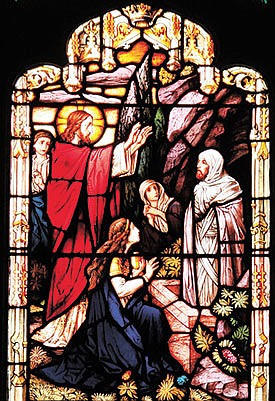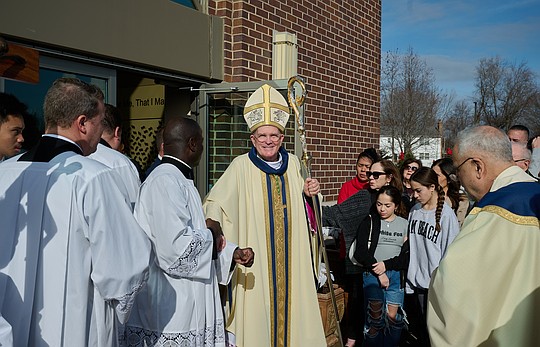Father Koch: Jesus destroys death forever
March 19, 2023 at 9:44 p.m.

No other miracle more than the raising of Lazarus from the dead defines Jesus and his ministry. By this point in his ministry Jesus has performed countless miracles. While each miracle carries with it multiple layers of meaning, and all of them ultimately point toward the full restoration of reconciliation as accomplished through the Paschal Mystery, none of them encapsulates this reality as poignantly and dramatically as does this miracle.
Jesus showed to his disciples that his power is not only over life and the healing of the living, but that his power extends even to death itself. This power over death, unheard of and awe-inspiring, is only a mere foreshadowing of the complete subjugation of death accomplished through his own Resurrection from the dead.
Jesus gets word that Lazarus is ill. While Jesus knows that this is a terminal illness, and that his good friend is suffering, Jesus chooses to remain where he is instead of going to his bedside. This is somewhat confusing to the disciples. Had Jesus tended to Lazarus as he was ill the expectations of a miracle of healing would have preempted the sign that Jesus intends.
John does not use a word that indicates “miracle” or “might works” in his Gospel. Rather, he uses the term semeion which means a “sign.” Each of the signs, and there are seven of them in the Gospel, points beyond itself to the mission of Jesus and also gives glory to God. The raising of Lazarus is the last of the signs and in a sense sums up the previous six.
The entire Gospel of John points to eternal life. Each sign, each conversation, all of the didactic moments, is fundamentally about eternal life. While many, if not most of the Jews at the time of Jesus, believed in eternal life, there was no agreed upon dogmatic position as to what it is or what it means.
In general terms there was a sense that at some point in the distant future God would bring all of his chosen people into his presence in an eternal realm, but they were unsure as to when or how. This is one of the reasons why when Jesus speaks of eternal life and resurrection from the dead, he gets various reactions among his audiences.
We see this playing out in the various dialogues in the Gospel passage about Lazarus. The friends and other family members of Lazarus who are sitting shiva with his sisters, Martha and Mary, react differently to Jesus’s arrival. Everyone, including the sisters, expresses their disappointment and, perhaps even anger, that Jesus was so delayed in coming. They are confident that he could have “saved” Lazarus from death. Now, there is confusion as to what he can and will do.
Jesus opens the conversation of resurrection with Martha and then with Mary. They both express their faith -- faith in the Resurrection and the faith in the power of Jesus. Jesus says to her: “I am the resurrection and the life; whoever believes in me, even if he dies, will live, and everyone who lives and believes in me will never die. Do you believe this?” She said to him, “Yes, Lord.I have come to believe that you are the Christ, the Son of God, the one who is coming into the world.”
Hers is a powerful testimony of faith. For her to identify Jesus and both Christ (messiah) and Son of God, is beyond that which many of the twelve have yet come to understand. She sees Jesus beyond the encounters of this world, indication that she has understood the signs that Jesus has already performed. Her testimony of faith -- over and against the sneering crowds around him, filled with doubt -- moves Jesus forward.
We see this overwhelming sense of doubt even more so when Jesus speaks with Mary. He does not ask Mary the faith question -- that has been asked and answered by Martha -- instead he moves now beyond the hostility and doubts of the crowd -- to see the body of his friend Lazarus.
Jesus has the tomb opened -- a tomb which has been sealed for four days -- so that he can perform his miracle.
In the voice of God Jesus issues a simple command: “Lazarus, come out.”
Still bound in his shroud, Lazarus reenters the world of the living.
This sign points to what will happen shortly after, as Jesus himself comes forth from his own tomb, this conquering death itself.
In the face of death each one of us is called to live in the “sure and certain hope” that we will all hear those words one day, and life with Christ in eternity.
Father Garry Koch is pastor of St. Benedict Parish, Holmdel.
Related Stories
Friday, January 02, 2026
E-Editions
Events
No other miracle more than the raising of Lazarus from the dead defines Jesus and his ministry. By this point in his ministry Jesus has performed countless miracles. While each miracle carries with it multiple layers of meaning, and all of them ultimately point toward the full restoration of reconciliation as accomplished through the Paschal Mystery, none of them encapsulates this reality as poignantly and dramatically as does this miracle.
Jesus showed to his disciples that his power is not only over life and the healing of the living, but that his power extends even to death itself. This power over death, unheard of and awe-inspiring, is only a mere foreshadowing of the complete subjugation of death accomplished through his own Resurrection from the dead.
Jesus gets word that Lazarus is ill. While Jesus knows that this is a terminal illness, and that his good friend is suffering, Jesus chooses to remain where he is instead of going to his bedside. This is somewhat confusing to the disciples. Had Jesus tended to Lazarus as he was ill the expectations of a miracle of healing would have preempted the sign that Jesus intends.
John does not use a word that indicates “miracle” or “might works” in his Gospel. Rather, he uses the term semeion which means a “sign.” Each of the signs, and there are seven of them in the Gospel, points beyond itself to the mission of Jesus and also gives glory to God. The raising of Lazarus is the last of the signs and in a sense sums up the previous six.
The entire Gospel of John points to eternal life. Each sign, each conversation, all of the didactic moments, is fundamentally about eternal life. While many, if not most of the Jews at the time of Jesus, believed in eternal life, there was no agreed upon dogmatic position as to what it is or what it means.
In general terms there was a sense that at some point in the distant future God would bring all of his chosen people into his presence in an eternal realm, but they were unsure as to when or how. This is one of the reasons why when Jesus speaks of eternal life and resurrection from the dead, he gets various reactions among his audiences.
We see this playing out in the various dialogues in the Gospel passage about Lazarus. The friends and other family members of Lazarus who are sitting shiva with his sisters, Martha and Mary, react differently to Jesus’s arrival. Everyone, including the sisters, expresses their disappointment and, perhaps even anger, that Jesus was so delayed in coming. They are confident that he could have “saved” Lazarus from death. Now, there is confusion as to what he can and will do.
Jesus opens the conversation of resurrection with Martha and then with Mary. They both express their faith -- faith in the Resurrection and the faith in the power of Jesus. Jesus says to her: “I am the resurrection and the life; whoever believes in me, even if he dies, will live, and everyone who lives and believes in me will never die. Do you believe this?” She said to him, “Yes, Lord.I have come to believe that you are the Christ, the Son of God, the one who is coming into the world.”
Hers is a powerful testimony of faith. For her to identify Jesus and both Christ (messiah) and Son of God, is beyond that which many of the twelve have yet come to understand. She sees Jesus beyond the encounters of this world, indication that she has understood the signs that Jesus has already performed. Her testimony of faith -- over and against the sneering crowds around him, filled with doubt -- moves Jesus forward.
We see this overwhelming sense of doubt even more so when Jesus speaks with Mary. He does not ask Mary the faith question -- that has been asked and answered by Martha -- instead he moves now beyond the hostility and doubts of the crowd -- to see the body of his friend Lazarus.
Jesus has the tomb opened -- a tomb which has been sealed for four days -- so that he can perform his miracle.
In the voice of God Jesus issues a simple command: “Lazarus, come out.”
Still bound in his shroud, Lazarus reenters the world of the living.
This sign points to what will happen shortly after, as Jesus himself comes forth from his own tomb, this conquering death itself.
In the face of death each one of us is called to live in the “sure and certain hope” that we will all hear those words one day, and life with Christ in eternity.
Father Garry Koch is pastor of St. Benedict Parish, Holmdel.










